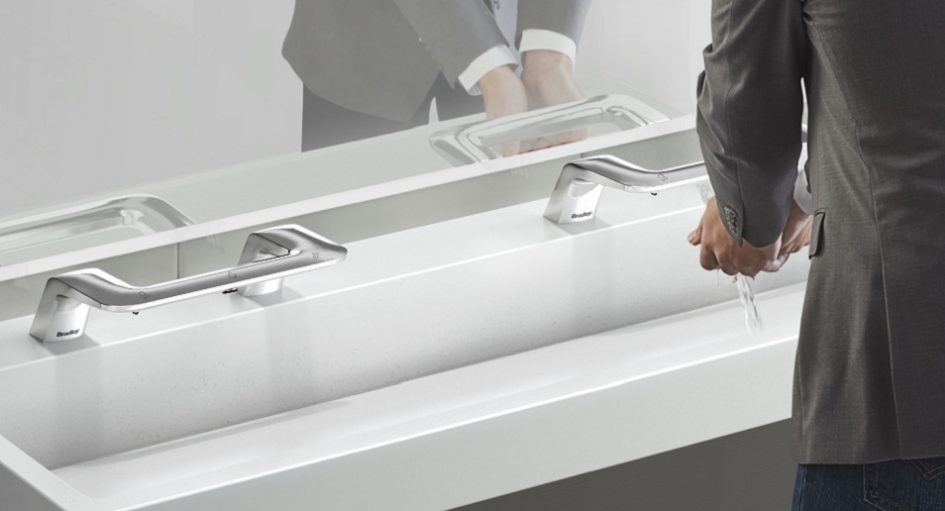The COVID-19 pandemic has brought with it a heightened awareness of cleanliness, specifically the importance of hand washing in preventing infection. Still, as commercial washrooms welcome numerous guests over the course of a single day, they can become a juggernaut of health and safety hazards, if not handled correctly.
According to Jon Dommisse, director of strategy and corporate development for Bradley Corp., a global manufacturer of washroom equipment: “Today’s commercial washroom will be of paramount importance in providing hand washing systems and supplies, and mitigating sickness-causing germs.”
Dommisse recommends that the following simple steps be implemented to keep washrooms clean, maintained, well-equipped, and prepared for a healthy hand washing experience:
- Post signage. Reinforce cleanliness with friendly reminders about washing hands for 20 seconds per Centers for Disease Control (CDC) and Public Health Agency of Canada guidelines, maintaining safe distances between users, throwing away paper towels, etc. The Healthy Hand Washing Survey by Bradley Corp. shows that 40 per cent of Americans increase hand washing when signs are posted.
“Posting updated cleaning schedules in restrooms also goes a long way in helping to reassure customers the facility is taking steps to ensure a clean environment and cares about keeping them safe,” Dommisse said.
- Offer touchless fixtures. Cross contamination of germs in washrooms can be reduced by using touch-free fixtures for everything from soap, faucets, hand dryers/towels, doors, and flushers. Public health experts agree. According medical microbiologist Michael P. McCann, Ph.D., professor of biology, Saint Joseph’s University: “Under any circumstance, using touchless fixtures helps to inhibit the spread of germs in restrooms and buildings. The more we avoid restroom touchpoints, the healthier and easier our operations will be. Hands-free washrooms are a win-win for consumers and businesses.”
Research shows that consumers are highly in favour of using touch-free fixtures. “Ninety-one per cent of Americans believe it’s extremely or somewhat important that public restrooms are equipped with touchless fixtures,” Dommisse said.
- Increase cleaning, sanitization, and restocking. Proper and frequent cleaning and disinfection is key for washrooms, especially for high-touch surfaces, such as doorknobs, faucets, sinks, toilets, stall door openers, and paper towel dispensers. According to the CDC, daily cleaning with soap and water reduces germs, dirt, and impurities on the surface, and should be done frequently, especially in high-traffic areas.
“It’s also important to disinfect surfaces to kill germs at least once daily, and more often if the restroom is busy,” Dr. McCann said. Finally, be sure to check and restock supplies regularly, as low-stocked washrooms can be a pet peeve for users.
- Provide trash cans and hand sanitizer near exits. “Our research shows that 65 per cent of Americans use paper towel to avoid contact with restroom doors and faucets,” Dommisse said. “Keeping paper towels and waste containers near doorways can be helpful so people can throw them away upon exiting.”
Installing hand sanitizers outside washrooms is another way people can sanitize their hands upon entering and leaving the washroom.
- Prop open doors to increase visibility and minimize contact. To limit the number of people in washrooms and encourage social distancing, a propped open door can give people a small window into seeing how many others are already inside. In addition, a slightly opened door allows people to maneuver the door with their elbow, as opposed to their hands.
About Bradley:
Bradley is a leading manufacturer of commercial plumbing fixtures, washroom accessories, restroom partitions, emergency fixtures and solid plastic lockers. For more information on hand washing best practices, visit their website.










You made an interesting point when you explained that it is important to increase sanitization in order to keep a public restroom clean. I would think that it would be a good idea to use toilet drops to help keep a toilet fresh in between cleanings. A toilet drop would help you keep odors down in a public bathroom.